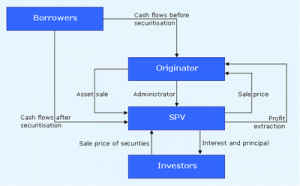Credit derivatives are privately held negotiable bilateral contracts that allow users to manage their exposure to credit risk. To be precise, Credit derivatives are financial assets like forward contracts, swaps, and options for which the price is driven by the credit risk of economic agents. To explain it take an example, a bank concerned that one of its customers may not be able to repay a loan can protect itself against loss by transferring the credit risk to another party while keeping the loan on its books.
A credit derivative’s value is derived from the credit risk on an underlying bond, loan or any other financial asset. The credit risk is on an entity other than the counterparties to the transaction itself. This entity is known as the reference entity and may be a corporate, a sovereign or any other form of legal entity which has incurred debt. Credit derivatives are bilateral contracts between a buyer and seller under which the seller sells protection against the credit risk of the reference entity.
Types :
Credit derivatives are divided into two categories:
1) Funded credit derivatives
2) Unfunded credit derivatives
An unfunded credit derivative is a bilateral contract between two counterparties, where each party is responsible for making its payments under the contract (i.e. payments of premiums and any cash or physical settlement amount) itself without recourse to other assets.
A funded credit derivative involves the protection seller (the party that assumes the credit risk) making an initial payment that is used to settle any potential credit events. The advantage of this to the protection buyer is that it is not exposed to the credit risk of the protection seller.
Risks
Risks involving credit derivatives are a concern among regulators of financial markets. One challenge in regulating these and other derivatives is that the people who know most about them also typically have a vested incentive in encouraging their growth and lack of regulation.
